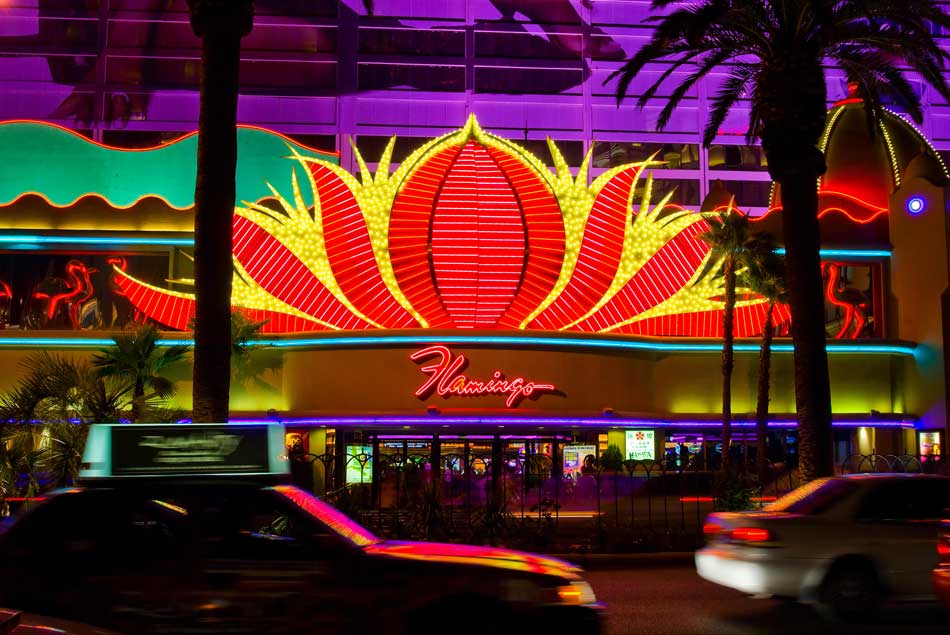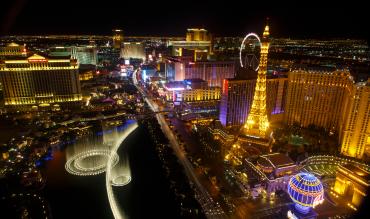It’s easy to stay at one of the new, shimmering casinos on the Las Vegas Strip or thereabouts. And we’re advocates for doing just that.
The Fontainebleau, for example, is new, cushy and compelling. Opened late last year, it features a state-of-the-art spa, fabulous restaurants (La Fontaine is a terrific Frenchified spot for gourmet dining) and a nightclub that will have you dancing all night.
But, also, there is something to be said for checking into the town’s oldest joints. They tend to be comfortable, friendly, dripping with history and best bets for value hunters. Knowing where Las Vegas used to be can provide a great counterbalance to explorations of where the ever-changing city is heading next.
Here then are four of our favorite casino/hotels that drip history and provide great experiences.
GOLDEN GATE
Not only is this the oldest continually running gambling den in Las Vegas, but it is also a great bargain with recently renovated rooms usually going for less than $100 per night, even on the weekends. Opened in 1906, the Golden Gate was lauded for its electric lighting and steam heat.
The city’s first phone number was installed at the Golden Gate, though gambling was temporarily put on ice – between 1910 and 1931, when the likes of poker and roulette were outlawed in the burgeoning Sin City.
These days of course, the place, fittingly situated at 1 Fremont Street, is loaded with all the gambling you can desire. Upon checking in, don’t forget to get a gander at the display case, which features mementos from the early days.
EL CORTEZ
This is my favorite place to gamble. I love the clutch of blackjack tables located in the rear of the casino, with low limits, friendly dealers and a good-natured pit crew.
Best of all: The single deck games that pay 3 to 2 on blackjacks (these days, the much less advantageous 6 to 5 seems to be everywhere outside of the high limit rooms).
Located downtown, right on Fremont Street, the El Cortez was built in 1941 and billed as downtown LV’s first full-on resort. In 1945, the joint was purchased by a group of mobsters who included Bugsy Siegel and Meyer Lansky. Tribute is now paid to Bugsy via the Cortez restaurant, Siegel’s 1941, where the prime rib special is a must-order item.
Beyond the food, the Parlor Bar puts on performances of bands playing vintage jazz that takes you back to another era. Back it up with a quick jaunt through the Cortez’s History Hallway, where black-and-white photos capture the early days of Vegas in general and the El Cortez in particular.
If you want to soak up history with comfort and style, be sure to reserve one of the hotel’s 47 original rooms. They received top to bottom renovations in 2022. No doubt, Bugsy Siegel would approve.
GOLDEN NUGGET
The Nugget, as it’s known, reigns one of the fancier places downtown and it was built to be that way, constructed at a cost of $1 million in 1946. The joint’s founder, Guy McAffee, was perfect for Vegas. He came there from nearby Los Angeles with a posse of mobster pals and a history of running illegal nightclubs after his stint as a crooked cop.
Reportedly, McAffee invited 20,000 people to the grand opening and hosted some of the highest poker games in town. Over time, though, the Golden Nugget was eventually eclipsed by places on the Vegas Strip. If it did not exactly go to seed, well, it was on the way.
In 1972, Steve Wynn came to the rescue. Taking a controlling interest, he restored the Golden Nugget back to its original luster. The place changed hands multiple times after Wynn sold it to MGM and MGM sold it to a fresh set of owners. Wynn, if nothing else, was a masterful showman, and the place retains no small amount of head-turning amenities.
Tourists come to check out the Tank Pool – loaded with sharks – and guests enjoy the $30 million swimming pool, complete with a slides that whip you through the shark tank. Thanks to Plexiglass encasement, a drop into the pool is a gamble in which you can’t lose. Goldennugget.com
THE FLAMINGO
While Guy McAffee was getting the Golden Nugget in motion, his organized crime pal Bugsy Siegel was breaking ground on a main thoroughfare that came to be known as the Las Vegas Strip.
That’s where the Fabulous Flamingo stood. Opened in 1946, it was the third casino to be built on the Strip (first up on what would pretty much define Vegas was the El Rancho) and stood out as the costliest spot in town, constructed with a $6 million budget.
The idea was right – put up luxurious digs (including Seigel’s penthouse, which took up the entire fourth floor), bring in top-flight entertainment (the likes of Jimmy Durante and later Wayne Newton), lure rich gamblers from around the world – but the execution must have been flawed. The Flamingo flopped in record time. By 1947, other mobsters had it under their control and Seigel took a bullet to the head in June of that year.

What marked the end of Seigel also seemed to mark the beginning of the Flamingo and high-end Vegas as we now know it. The property turned over $4 million in profit during 1948 and Vegas proved to be fertile ground for organized crime.
While the Flamingo has switched ownership a number of times – one of the bosses, in 1953, added the Champagne Tower, which was fronted with bubbling neon – it is now in the hands of Caesars Entertainment and rules as the oldest, still-operating casino on the Strip.
The tropical themed pool remains in full effect and the spirit of Hunter S. Thompson, who stayed there while reporting “Fear and Loathing in Las Vegas,” still haunts some of the rooms. Speaking of which, the Fab Rooms are the oldest and most loaded with history (a plus or minus, depending on how you see things) and high-floor Flamingo rooms are the pinkest and newest and offer views of the flamingo loaded Habitat.
Where would I stay? Like a blackjack player dealt a pair of Aces, I’d split ‘em, and spend half of my time in each room.


